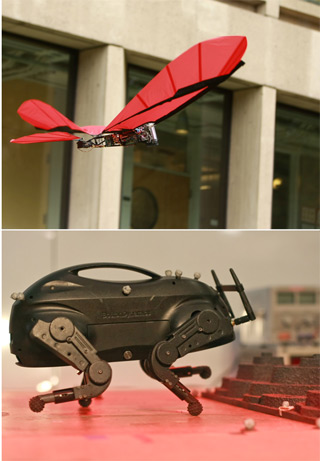
Legged robots and flying robots, including these examples from the MIT Robot Locomotion Group, are underactuated. (Photographs are courtesy of Jason Dorfman.)
Instructor(s)
Prof. Russell Tedrake
MIT Course Number
6.832
As Taught In
Spring 2009
Level
Graduate
Course Description
Course Features
- Video lectures
- Projects (no examples)
- Assignments: problem sets with solutions
- Assignments: programming with examples
- Exams (no solutions)
Course Description
Robots today move far too conservatively, using control systems that attempt to maintain full control authority at all times. Humans and animals move much more aggressively by routinely executing motions which involve a loss of instantaneous control authority. Controlling nonlinear systems without complete control authority requires methods that can reason about and exploit the natural dynamics of our machines.
This course discusses nonlinear dynamics and control of underactuated mechanical systems, with an emphasis on machine learning methods. Topics include nonlinear dynamics of passive robots (walkers, swimmers, flyers), motion planning, partial feedback linearization, energy-shaping control, analytical optimal control, reinforcement learning/approximate optimal control, and the influence of mechanical design on control. Discussions include examples from biology and applications to legged locomotion, compliant manipulation, underwater robots, and flying machines.
Professor Tedrake offered an updated version of this course that can be accessed through the edX platform.
Acknowledgements
Professor Tedrake would like to thank John Roberts for his help with the course and videotaping the lectures.


